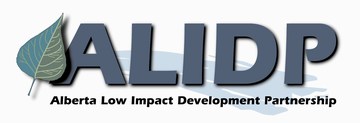British Columbia, Alberta and Ontario form an Inter-Provincial Partnership to promote Canada-wide use of the Water Balance Model
Collaboration will facilitate Green Infrastructure Practices
Leadership team representatives of the British Columbia Inter-Governmental Partnership (BCIGP), Alberta Low Impact Development Partnership (ALIDP), and the Toronto and Region Conservation Authority (TRCA) met in Calgary on October 31, 2007 to finalize the framework for an Inter-Provincial Partnership (IPP).
 “The Inter-Provincial Partnership will promote Canada-wide use of the national Water Balance Model as a tool to facilitate ‘green’ development practices,” announced Ted van der Gulik, BCIGP Chair.
“The Inter-Provincial Partnership will promote Canada-wide use of the national Water Balance Model as a tool to facilitate ‘green’ development practices,” announced Ted van der Gulik, BCIGP Chair.
“The appeal and the strength of the Water Balance Model is that it is evolving to meet the ‘needs and wants’ of participating agencies,” added van der Gulik.
The Water Balance Model is a public domain, on-line decision support and scenario modeling tool for promoting rainwater management and stream health protection through implementation of ‘green’ development practices, and can be found at www.waterbalance.ca.
Integration of the web-based Water Balance Model with the QUALHYMO computational engine was the critical ingredient in the partnership mix, noted both Liliana Bozic of ALIDP and Glenn MacMillan of TRCA.
Water Balance Model powered by QUALHYMO
Subsequent to the Water Balance Model Partners Forum in March, significant time and effort has been invested by Dr. Charles Rowney (Water Balance Model Scientific Authority) and members of his Expert Advisory Panel to fine-tune the QUALHYMO engine, in part to meet the needs of the Inter-Provincial Partnership. Rollout of the completed tool is now scheduled to commence in January 2008.
 The Water Balance Model powered by QUALHYMO means engineers will have a runoff-based tool for source control evaluation and stream health assessment. “Because QUALHYMO was developed by the Ontario Ministry of Environment in the 1980s, the integrated tool can truly be called the pan-Canadian tool,” observed Glenn MacMillan.
The Water Balance Model powered by QUALHYMO means engineers will have a runoff-based tool for source control evaluation and stream health assessment. “Because QUALHYMO was developed by the Ontario Ministry of Environment in the 1980s, the integrated tool can truly be called the pan-Canadian tool,” observed Glenn MacMillan.
“Our relationship with the BC partnership has already paid dividends,” added Liliana Bozic. “Over the past three years, members of the BC team have made numerous visits to Alberta to help us raise awareness of the need to change land development practices so that we capture rain where it falls.”
The Water Balance Model enables users to evaluate the effectiveness of site planning that incorporates source controls (such as absorbent landscaping, infiltration facilities, green roofs, and rainwater harvesting) in achieving performance targets for rainwater volume capture and runoff rate control under various combinations of land use, soil and climate conditions.
Integration of the Water Balance Model with QUALHYMO will enable local governments to achieve desired urban stream health outcomes at a watershed scale.
To Learn More:
To download a copy of the news release, please click on this link to British Columbia, Alberta and Ontario form an Inter-Provincial Partnership to promote Canada-wide use of the Water Balance Model
British Columbia Inter-Governmental Partnership (BCIGP)
 The BCIGP is a coalition of local, regional, provincial and federal government agencies and not-for-profit associations co-chaired by the BC Ministry of Agriculture and Lands and Environment Canada.
The BCIGP is a coalition of local, regional, provincial and federal government agencies and not-for-profit associations co-chaired by the BC Ministry of Agriculture and Lands and Environment Canada.
The goal of the BCIGP is to promote changes in land development practices, coupled with implementation of performance targets for rainwater management, so that the built environment will preserve and/or restore the natural water balance over time.
Albert Low Impact Development Partnership (ALIDP)
ALIDP is comprised of municipal and provincial governments, provincial agencies, and non-profit organizations that have a stake in promoting changes in land development practices so the degradation of natural environment is prevented or reduced.

ALIDP mission is to protect and maintain the integrity of the natural environment while promoting the growth and prosperity of Alberta’s urban centres.
The mission will be achieved through implementation of low impact development (LID) practices that lead to healthier urban watersheds.
ALIDP is co-chaired by the cities of Calgary and Edmonton.
Toronto and Region Conservation Authority (TRCA)
Since its formation in 1957, TRCA has been a leader in watershed management in Ontario. TRCA’s area of jurisdiction includes 3,467 square kilometers, comprising nine watersheds and eighteen member municipalities, including the City of Toronto  and the Regional Municipalities of Durham, Peel, and York. The nine watersheds within the Toronto region are home to more than three million people – one third of Ontario’s population.
and the Regional Municipalities of Durham, Peel, and York. The nine watersheds within the Toronto region are home to more than three million people – one third of Ontario’s population.
TRCA’s mission is to work with its partners to ensure that The Living City is built upon a natural foundation of healthy rivers and shorelines, greenspace and biodiversity, and sustainable communities.

